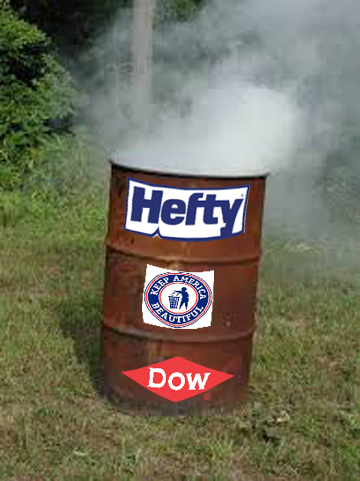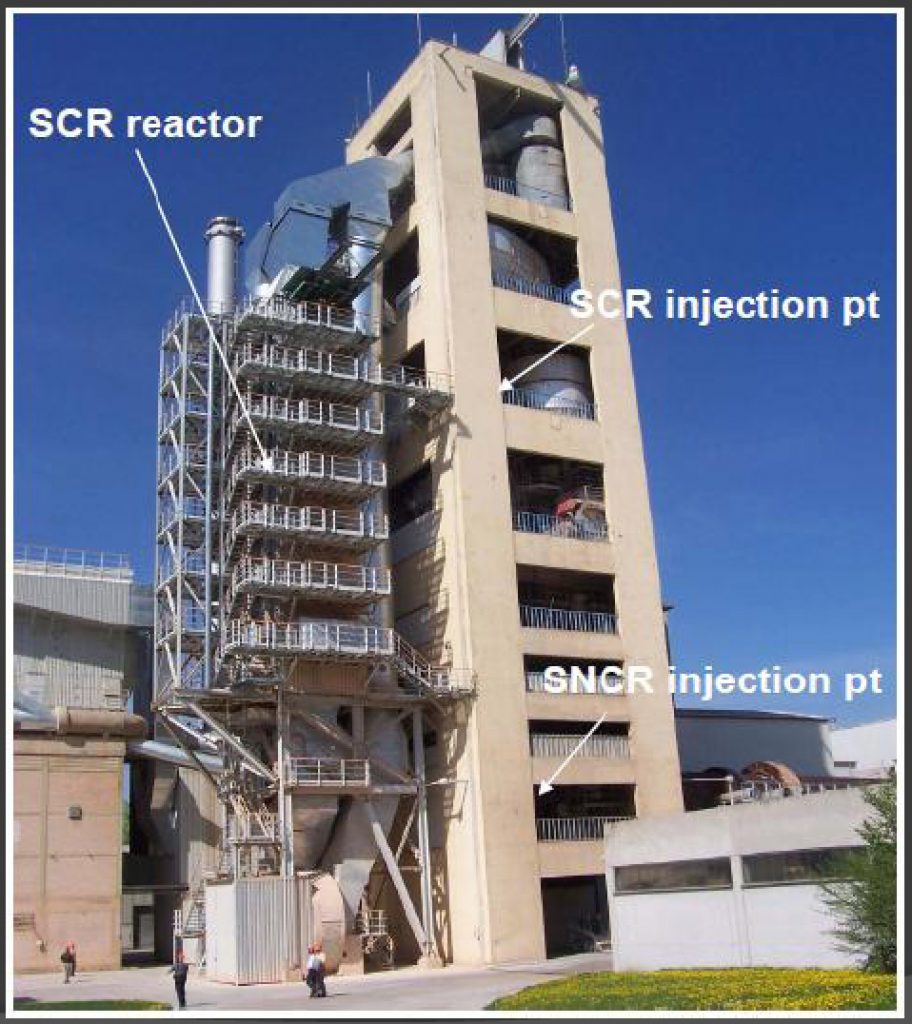air toxics
Meet Our New Campaign Targeting Toxic Particulate Matter: “NO SAFE LEVEL”
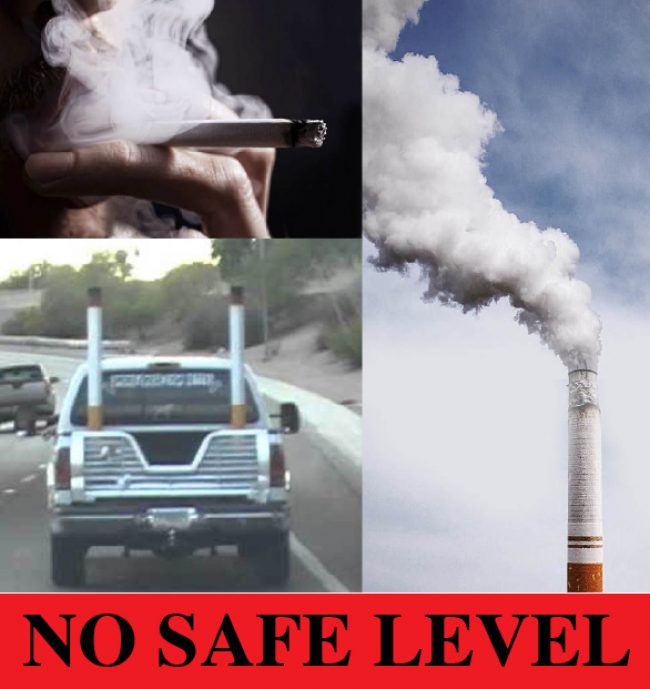
Toxic Particulate Matter – “PM” – is the New Lead
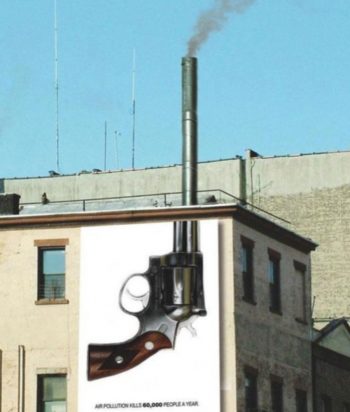
PM is the scientific name for industrial soot. It comes from burning things. Wood. Gasoline. Diesel. Coal. Waste. Everything that depends on on burning something, produces Particulate Matter: cars, trucks, buses, locomotives, boilers, furnaces, kilns, etc.
PM pollution is tiny. It’s much smaller than nature’s dust particles that our nose hairs, throat and lungs have evolved to handle most of the time. Because its so small PM pollution can actually pass through your lungs’ lining and goes directly into your bloodstream. From there it goes to any organ it’s carried to – the liver, the reproductive system, the brain.
Numerous studies have shown the terrible impact of PM pollution on human lungs and hearts.It causes heart attacks, strokes, asthma and COPD. More recent studies have shown a whole new threat. Exposure to PM is now linked to AHAD and Austim in children, and Dementia and Parkinson’s disease in adults. Immune system and reproductive organ damage have also been ties to PM exposure. Like lead in paint and gasoline, this pollution can do damage to a person’s social and intellectual capacities, not just physical ones

PUBLIC INFO & BRAINSTORMING SESSION:
The Dangers of PM Pollution and What We Can Do About It in DFW
Saturday, December 9th
2 – 4 pm
2900 Live Oak in East Dallas
ALL ARE WELCOME
This year the most comprehensive study on PM pollution health effects ever produced was published by Harvard’s School of Public Health. It covered 60 million people over 12 years.
It found significant health damage occurring at levels well below the current EPA standard and concluded there is no “safe” level of exposure to PM pollution. That is, there is no exposure that is not capable of doing some harm to you, no matter how small.
That same study found African-American seniors were three times more likely to die from PM exposure than any other group, with Latinos and Asians also suffering disproportionately. “Point Sources” (smokestacks) of PM are more likely to be in located in low-income communities of color. People of color are more likely to ride diesel-powered buses used for public transit or live along PM-spewing freeways. There’s no other type of pollution that’s linked so closely to how “undesirable” industries and people were forced to live next to one another over the decades.
Here in DFW we’ve flirted with high regional levels of PM pollution but we really don’t know the extent of it since the EPA and State only have four PM monitors for the entire DFW area of seven million people.
That’s why our first job is to help map PM pollution hot spots in DFW. Downwinders is building a “Citizen’s Guide to PM Pollution” that identifies all the largest sources of PM pollution – factories, railways, freeways, transit and school bus routes.
We’re purchasing portable PM pollution monitors citizens can use to police their own neighborhoods and helping to build a new monitoring network that cities can use to track events like the one on Oct 19th – that still remains a mystery.
What can be done in DFW to reduce our exposure to PM pollution? New controls on industry of course, including the cement kilns and coal plants. But also electrification of bus fleets, buffer zones beside freeways, and a detangling of pollution and people in places like West and South Dallas and the Northside of Fort Worth that require pushing the reset button on local planning.
Just turning bus route shelters 180° around so they don’t openly face street traffic has been found to reduce exposure to PM pollution by 30-50% for transit riders – one of the populations at highest risk for PM exposure.
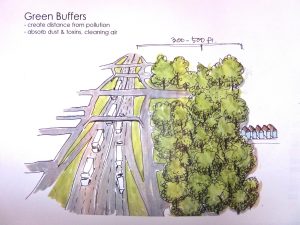
PM pollution is everywhere. It’s so ubiquitous we take it for granted. Much like people took cigarette smoking for granted 40 years ago. And that’s where we’re at with this campaign, at the very beginning of a massive public health education and advocacy effort, a no-smoking campaign for machines that also has the potential to reshape planning, politics, and culture. We have a huge task ahead of us. And we need your help.
Come join us on December 9th to learn more about this insidious from of air pollution and help us come-up with the best approaches for where to start reducing it in DFW.
Saturday, Dec. 9th 2-4 PM Meadows Conference Center 2900 Live Oak
Why Cement Kilns are Insatiable. And Why You Care.
 Dow, Hefty and Keep America Clean’s proposal to burn plastics via bright orange “energy bags” in cement kilns is new but the idea of using kilns as industrial kitchen dispose-alls is not.
Dow, Hefty and Keep America Clean’s proposal to burn plastics via bright orange “energy bags” in cement kilns is new but the idea of using kilns as industrial kitchen dispose-alls is not.
DFW has been identified as a national waste disposal destination because of its cement plants since at least the mid 1980’s. And as long as they continue to operate, the area will continue to be seen as a desirable dumping ground.
All these buildings, and roads, and “developments” have to be made out of something. They’re mostly made out of cement. In an area that’s grown by a Tyler or Richardson a year since 1970, cement is as ubiquitous as the air in your lungs. You just take it for granted. But it comes from somewhere and it gets made someplace.
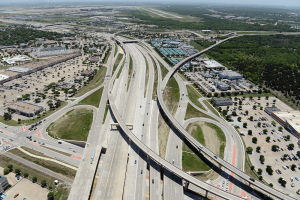
Brought to you by…Cement!
In our case, that place is here – right over there, in Midlothian, just a couple of miles across the Dallas and Tarrant County lines to the south. You know, the direction the wind blows from most of the time.
And its a big place. There’s a Chamber of Commerce sign in downtown Midlothian proclaiming the town the “Cement Capitol of Texas.” There are three large cement plants – TXI, Ash Grove and Holcim – that quarry the limestone rock they need from the escarpment that runs north-south along I-35 for most of the length of the state. But the sign is too modest. Befitting one of the fastest growing areas in the country, it’s the largest concentration of cement manufacturing in the nation.

The Chamber of Commerce sign in downtown Midlothian
These aren’t batch plants. Think coal plants. Smokestacks hundreds of feet high. Furnaces, or kilns, as long as football fields. In 2015, the three plants released 475 tons of Particulate Matter pollution, 2040 tons of Sulfur Dioxide, and 510 tons of Volatile Organic Compounds – more pollution than the totals from entire North Texas counties.
That pollution goes somewhere. Depending on where you live, some of it lands in your lungs.
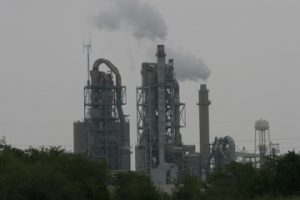
Holcim – one of three Midlothian cement plants
All three cement plants are in Midlothian to mine the limestone rock just like coal plants would strip-mine coal. Midlothian has a lot of cement kilns because that’s where the raw material for cement is, not because of any other reason.
But unlike coal, the limestone isn’t flammable and for there to be cement, the kilns must reach and maintain a flame of at least 1700 degrees F to bake the limestone with other ingredients. This is the way cement has been made since Rome perfected the process two millennia ago. You bake rock…just so.
And that flame is your number one operating expense as a cement plant owner. It accounts for up to 40% the costs of doing business. Anything you can do to reduce the costs of that flame saves you money. And that equation is the basis of constant mischief in the industry.
When the first Midlothian cement plant opened in 1960, and when the second one opened in 1965, the rock was baked with fire fueled by Texas natural gas. By the time the third cement plant opened in the mid-1980’s , the first couple of “energy crisis” had hit and they all three begun to burn cheaper coal.
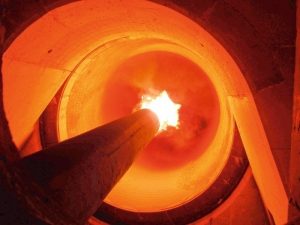
The lance of the flame inside a cement kiln, or furnace
But another trend started in the 1980’s. Two of the three cement plants took advantage of a loophole in a new federal law and began burning hazardous wastes to bake their limestone rock.
Unlike gas and coal, the cement plants were paid by hazardous waste generators and middlemen to burn these wastes, so the plants not only saved the cost of buying fuel, they actually profited from becoming incinerators, and labeling waste as “fuel.” Hazardous waste burning at U.S. cement plants peaked in the 1990’s.

Air computer model of where the smog pollution from all three Midlothian cement plants goes during a typical year
Even after many cement plants have stopped burning hazardous wastes, they continue to burn “industrial wastes” like used oil, tires and shredded car interiors. When burned in kilns, these waste often produce exactly the same toxic air pollution as hazardous wastes. That’s what’s happening in Midlothian now. Although decades of citizen action have modernized the equipment and stopped the burning of official hazardous waste, the three cement plants continue to burn a wide variety of materials, and the pollution continues to blow wherever the wind takes it.
As long as there’s limestone to be mined, the cement plants will remain open in Midlothian. As long as they stay open in Midlothian, they’re going to try to burn all kinds of wastes. When they do, they release a lot of toxic air pollution. And as long as the wind patterns stay the same that means that seven million DFW residents will be exposed to that toxic air pollution.
And that’s the reason why DFW is always just one multinational decision away from being downwind of a huge hazardous waste incinerator again, or a municipal waste incinerator, or a medical waste incinerator: Because we’re already downwind of the three hungry cement plants that need to burn any and everything they can get their hands on, the cheaper the better. And if they can get paid to throw things in the fire, well that’s a business formula they can get behind. As long as they need to feed their flames, they’re out combing the streets for things to burn – including “hard to burn plastics” for an industry that needs its own greenwashing cover story.
Until the manufacturing of cement no longer demands a sun-hot flame, or they run out of limestone rock, the Midlothian cement plants pose pose a huge on-going air pollution threat. The Dow project to burn plastics is just the latest, but not last, chapter. That’s why as long as there’s cement being made here, there also needs to be vigilant downwinders.
HEFTY! HEFTY! HEFTY! is TOXIC! TOXIC! TOXIC!
Anti-Litter Group “Keep America Beautiful” Teams-Up with Dow and Hefty to Burn Plastic Bags Full of Plastic Garbage in Cement Kilns
And They Want To Do It Here…
We’ve been warning you for a while that garbage burning was coming to North Texas one way or another.
What we didn’t anticipate was that “Keep America Beautiful” would bring it.
That’s right. The same group that gave you Oscar “Iron Eyes” Cody crying over litter is now prepared to make your own eyes water and sting from the air pollution it wants to encourage by burning municipal solid waste, especially “hard-to-recycle” plastics.
Touting bright orange “energy bags” as a quick and easy alternative to throwing those plastics away, a news release issued by the Keep America Beautiful folks, your friends at Dow Chemical, and Reynolds, the makers of “Hefty” trash bags, claims they’re “a convenient way to collect plastic materials that would otherwise end up in the landfill and offers a platform to promote positive behaviors to prevent this material from being wasted.”
What they don’t tout as much is their alternative to throwing these plastics into a landfill – throwing them into a furnace.
As long as cement kilns need a high-temperature flame to make their product, they have large energy costs. Typically, 30% or more of the costs of running a cement plant is in buying the flammable materials necessary to keep that flame lit.
 History has taught us that cement kiln operators will burn anything, including the kitchen sink, if they think it will help reduce those high fuel costs.
History has taught us that cement kiln operators will burn anything, including the kitchen sink, if they think it will help reduce those high fuel costs.
Kiln flames in Texas used to be powered by natural gas exclusively. Then it was coal. Then it was hazardous waste and coal. Then industrial wastes. And now municipal solid wastes. In bright orange plastic bags.
Cement plants don’t have to pay for the wastes, now termed “fuel,” for regulatory loophole purposes. In fact, because it’s now a “fuel,” they often get the waste for free or even get paid to burn it. It becomes a new center of profit in the company besides making cement. Maybe even more important. In the 1990’s, there were plenty of rumors about how the TXI cement plant in Midlothian would burn a lot of hazardous waste they got paid a handsome fee to take, but not have much cement product to show for it.
While garbage burning cement kilns have been on the rise in the developing world, the practice hasn’t caught on in the U.S.
Dow’s and Keep America Beautiful’s friendly neighborhood “Energy bags” are a way to jump start it.
This is already happening in Omaha, where 8,500 homes have filled 13,000 “Hefty Energy Bags” since the program’s launch in October. That’s resulted in more than 13,000 pounds of plastics being burned in a near-by Ash Grove cement kiln. They’re so excited about burning plastics at Keep America Beautiful that they’re not only endorsing the practice, they want to bring it to a cement kiln near you.
At a news conference to announce the offering of cash money grants to local communities who wanted to try the option, they unveiled a contiguous states map of the US where they’d like to see the “energy bag” concept implemented. The approximately 50 locations on the map identified by a red (not orange?) star are almost all sites adjacent to large cement plants – including Midlothian, immediately south of the Dallas and Tarrant Counties line, and home of the largest concentration of cement manufacturing in the nation.

Local candidates for eager participation in the project include TXI, the cement plant that burned hazardous waste by the thousands of tons from 1987 to 2008, Holcim, which has sought permits to burn carpet scraps and shingles, and Ash Grove, the same operator as the one burning Omaha’s plastic bags now.
BURNING PLASTIC IS BAD FOR PUBLIC HEALTH AND PUBLIC POLICY
1. It replaces real recycling with burning.
Once you have a hungry garbage burner, you have to keep feeding it with more and more garbage, decreasing the market for real recycling.
This is already happening with tires. There are good tire recycling programs that can’t stay afloat because local governments have promised the local cement kilns a certain volume every year.
2. It gives an incentive to the plastics industry keep to just making plastics that you can’t recycle.
Burning plastic garbage is like a relief valve on the growing piles of “hard to recycle” plastics that industry is producing. Just throw it in a bag and send it to the kiln. Out of sight, out of mind. There’s no question it reduces the percentage of plastics going to landfill…only to increase the percentage of plastic going into your lungs.
The real answer is to reduce and quit producing those “hard-to-recycle” plastics, not giving them a cheap way to get out of doing so.
3. Burning plastic produces lots of toxic air pollution – and all of DFW is downwind of Midlothian
Burning plastics produces toxic air pollution, a percentage of which escapes the smokestack and ends up in the air you breathe, the soil in your garden, and the food you eat and drink. Specifically, burning plastic creates lots of Dioxins and Furans – the same ingredients that made Agent Orange so toxic. The same poisons that made the State of Missouri evacuate the town of Times Beach in 1983.
Burning plastic also releases metals into the air, like cadmium and lead.
Other chemicals released while burning plastics include benzo(a)pyrene (BAP) and polyaromatic hydrocarbons (PAHs), which have both been shown to cause cancer. If plastic film or containers are contaminated with pesticides or other harmful substances, those will also be released into the air. If plastics are burned with other materials, whole new toxic chemicals may be created from the interaction of the different substances.
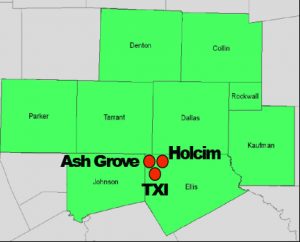
But wait! Don’t you want to divert more garbage from going to landfills?
Yes you do, but by eliminating, reducing and recycling the garbage – not taking a match to it.
Landfills are nasty things. They’re big and smelly and they leak. Sometimes they leak and contaminate ground and surface water. But these days you usually can trace the plume of those leaks and contain them before they get in drinking water.
On the other hand, once a piece of dioxin-contaminated soot is shot through a smokestack into the atmosphere, you have no idea where it’s going. You’re turning the whole sky into a landfill, full of solid and gaseous residues of refuse. What you didn’t want to drink, you’re now breathing. That’s the opposite of progress.
Taking a look at the Board of Directors for Keep America Beautiful, it’s no wonder they have a soft spot in their heart for large plastics manufacturers. They have not one, but two members from DOW, who, we are sure, thought this was a splendid idea.
Howard Ungerleider is Vice Chairman and Chief Financial Officer of Dow, and Greg Jozwiak is the Business President for the Elastomers and Electrical and Telecommunications businesses for the company. Prior to assuming his current role, he served as North America Commercial Vice President for the Packaging & Specialty Plastics business. Hmmmm.
But wait, there’s more! KAB has a board guaranteed to offend just about everyone. Not content with two Dow executives, it also has two Nestle Corporation members, a representative of Waste Management Inc., McDonalds, Keurig, Anheuser-Busch, and Phillip Morris – yes, that Phillip Morris.
“PEOPLE START POLLUTION. PEOPLE CAN STOP IT.”
Those are the words, spoken in a deep baritone by William “Cannon” Conrad, that ended that famous 1971 Keep America Beautiful commercial in honor of Earth Day. They ring as true now as then.
And so, people, we’re asking you to take action to discourage this kind of BAD IDEA from ever coming-up at a Keep America Beautiful board meeting again – send an email to their new Chair, Helen Lowman.
Ms. Lowman is a former FEMA and Peace Corps executive in the Obama Administration. She’s from Texas, worked at TCEQ, and graduated from Austin College…. So maybe messages from her fellow Texans will have more of an impact.

TAKE ACTION:
TELL KEEP AMERICA BEAUTIFUL’s NEW CHAIR YOU DON’T WANT TO BREATHE TOXIC AIR POLLUTION FORM BURNING PLASTICS
SEND AN EMAIL WITH JUST TWO CLICKS
And if you want to leave a public message for the group too, here’s the group’s FaceBook site.
Other citizens groups, including some national alliances and networks are gearing up to take on this latest proof that all wastes, no matter how toxic, roll downhill to cement kilns eventually.
Meanwhile, Downwinders is taking the lead and beginning the push back we hope buries this project in the bright orange trash heap of history. Join us in not just saying “No,” but “Hell No.” Send that email now and then find two other people that will do the same. Thanks.
Pics from Our “Meet the Drones” Mixer
 Here's the link to some pictures of our October 6th "Meet the Drones" Mixer featuring the squadron from University of Texas at Dallas.
Here's the link to some pictures of our October 6th "Meet the Drones" Mixer featuring the squadron from University of Texas at Dallas.
Thanks to TCU's Dr. Mike Slattery for hosting the public debut of our North Texas CLEAN Air Force – an exciting new effort combining citizen know-how with academic expertise to better help us identify DFW air pollution problems. Representatives from TCU, UTA, UTD, UNT, UNTHSC were on site. Thanks as well to all the supporters and curiosity-seekers who showed up to see the show.
This was the first of what we hope will be a series of such events around North Texas to show off the capacity and potential of this new tool for citizens. Stay tuned for news on when we'll be coming to a campus near you.
We Did It: After 15-Years of Persistent Organizing, Citizens Finally See Modern Controls on a Midlothian Cement Plant. And Now We Want It on All of Them
 Holcim is the first cement plant in the nation to voluntarily install an industrial catalytic converter called SCR on its smokestack, significantly cutting smog-forming air pollution in DFW.
Holcim is the first cement plant in the nation to voluntarily install an industrial catalytic converter called SCR on its smokestack, significantly cutting smog-forming air pollution in DFW.
But despite operating only 26 miles from EPA headquarters, the Agency and State of Texas still claim the technology isn't "feasible"
Downwinders is proud to announce Midlothian's Holcim cement plant is the first in the nation to voluntarily install pollution control equipment significantly cutting smog-forming air pollution, along with other dangerous emissions.
"Not many people may notice, but Friday is a big day for air breathers in DFW, as well as for everyone in the country who lives downwind of a cement plant," said Tamera Bounds, Chair of Downwinders at Risk, the clean air group that's been relentless in its pursuit of the technology for North Texas since 2001.
Friday marks the official deadline for Holcim's Midlothian cement plant to have its Selective Catalytic Reduction, or SCR system, up and running on one of its two giant kilns in order to be compliant with EPA emissions limits.
Although almost a dozen cement plants in Europe have installed the technology over the last twenty years and it's widespread in the American coal industry, Holcim is so far the only cement plant in the U.S. to install SCR on one of its kilns without a government mandate.
A pilot test using SCR at Midwest cement plant was required by a Department of Justice enforcement action in 2010. Results show smog-forming pollution was cut by at least 80% – roughly twice as much as pollution controls now in use in the US, including Midlothian. In Europe, SCR has a track record of removing 80-90% or more of the smog-forming pollution that has kept DFW in violation of the Clean Air Act since 1991. It also cuts the emissions of air toxics, particulate matter, and dioxins by double-digits.
With three cement plants and four kilns, Midlothian hosts the largest concentration of cement manufacturing in the US, and the largest "stationary" sources of air pollution in DFW. Since the late 1980's, the city has become a national battleground over cement plant pollution. First, over the use of hazardous waste as "fuel" for the local kilns, then over the closing of dirtier, obsolete "wet" kilns contributing to smog and climate change, and now over how fast new kilns can be updated to reflect 21st technology. 
Bounds and others say the installation of SCR on all four kilns in Midlothian would mean a huge benefit to public health for residents in Tarrant County, where the predominant winds push the plumes from the kilns. A 2009 Cook Children's Hospital study showed childhood asthma levels highest directly downwind of the cement kilns.
The demand for the technology is a central part of the group's push to replace the current State-sponsored anti-smog plan with a more effective, and protective, one from EPA. So far, Dallas County, the City of Dallas, two Congressional Representatives and a State Legislator agree with them. But incredibly, the Agency maintains the SCR technology Holcim has freely invested in to reduce pollution and is already operating less than 30 miles from its regional headquarters is not "technically feasible."
Downwinders and other groups in the DFW Clean Air Network regional alliance are challenging EPA's refusal to recognize a game-changing pollution control technology that could help DFW finally put its smog problems behind it a well as offering similar help to other parts of the country downwind of cement plants.
"It's rare these days to find the EPA embracing Texas' approach to ignoring advances in environmental science, but that's exactly what happening," said Bounds. "Both State and EPA officials are acting like 3rd Graders – closing their eyes and humming loudly, pretending this time-tested technology isn't operating right in front of them. But it does, and it's here to stay."
Bounds wants the EPA to take note of the cuts in pollution triggered by Holcim's operation of its SCR system and then hold ALL the Midlothian plants to the same modern standard. "You have a piece of equipment that is setting a higher bar for pollution control. Every cement kiln in DFW should have to meet that higher bar now. No other anti-pollution strategy makes sense."
It's been a long and circuitous route to getting SCR installed in a Midlothian cement kiln. Along the way, the region's clean air activists moved the entire nation closer to widespread use of this control technology.
North Texans first heard about the use of SCR in the cement industry through a citizens group fighting a proposed new cement plant in New York state in 2001.They'd commissioned a study from a NYC engineering firm identifying European cement plants that had already successfully installed the technology.
Downwinders tried and failed to include SCR in the anti-smog plan in 2003. It then used a 2005 settlement agreement with the State over the failure of that plan to get the then Rick Perry-controlled Texas Commission on Environmental Quality to perform an independent assessment of the technology. That landmark study produced results that are still reverberating today. In it, five independent experts chosen by Downwinders, the cement industry, and the State declared SCR to be ready for prime time.
"SCR is a commercially available technology. It offers the possibility of significant NOx reduction at the plants in Ellis County. As an 'add on' technology, which can achieve 90% or greater NOx reduction, with demonstrated performance at hundreds of coal fired power plants, SCR is a viable technology that is available for both dry and wet kilns."
That conclusion, from cement industry experts, in a TCEQ study, is now a decade old.
At the same time they were working to bring SCR to Midlothian, Downwinders also led the fight for new EPA emission limits on cement kilns that burn hazardous waste. A 2009 national hearing at DFW Airport attracted over 200 people. Those emission limits clamped down on air toxics. Holcim couldn't meet them without adding controls. They choose an SCR unit on one kiln and a thermal oxidizer (re: flame) on the other to try and stay in compliance. Even though Holcim installed SCR to address air toxics, or Volatile Organic Compounds and not smog pollution, the effect on emissions will be the same.
Meanwhile, the 2006 TCEQ study and subsequent push by Downwinders for SCR in Midlothian helped persuade the EPA to require the pilot test in 2010. That test, as well as Holcim's experience in Europe, set the stage for SCR's official debut on the Texas prairie on Friday.
"It's been a long fight, but change is hard," said Bounds, "and it doesn't happen in a straight line."
Help Us Celebrate This Victory That Was 15 Years in the Making
Please consider contributing $25 or more on "GIVING DAY" NEXT THURSDAY to keep us on the front lines of change another 15 years.
Giving Day is an all day online giving event sponsored by the Communities Foundation of Texas.
Downwinders will have our own online Giving Day page where you can click and give from 6 am through 12 Midnight next Thursday.
Every contribution of $25 or more is matched or extended by the Foundation.
This year, we need your support to keep our full-time staff in the field, as well as fund our 2nd annual Root and Branch Revue for activists, and assemble our North Texas Clean Air Forceof air-monitoring drones.
Oh yeah, we're also opening a school for organizers in January.
We're based in DFW. All our board members are from DFW. Our priority is DFW air. Your contribution stays in North Texas to fund the fight for clean air in North Texas.
We know you're being assaulted by Giving Day appeals from all the local non-profits, and there are lots and lots of good causes. We only request that you ask yourself how many other local groups can repeatedly pull off meaningful victories with so few resources?
We were able to bring SCR to Midlothian with your help. We need your help again next Thursday. We think we've earned it.
Thanks.
New Study: Premature Births Caused by Dirty Air Cost the US $4 billion a Year
 There are no shortages of studies linking bad air with birth defects and premature births. But until now no one has taken on the task of trying to add up the national toll in both lives and money.
There are no shortages of studies linking bad air with birth defects and premature births. But until now no one has taken on the task of trying to add up the national toll in both lives and money.
In a study published in Environmental Health Perspectives on Tuesday, UCLA researchers estimated that almost 16,000 premature births across the country in 2010 — about 3 percent of the nationwide total of 475,368 — were related to exposure to high levels of "air polution" – in this case the insideous and ubiquitos Particulate Matter, or PM. These premie births cost the system $4.33 billion, including $760 million spent on prolonged hospital stays and long-term use of medications, as well as $3.57 billion in lost economic productivity due to physical and mental disabilities associated with preterm birth.
"For policy makers, decisions about regulating air pollution come down to a trade off between the cost of preventing air pollution and the health and economic benefits of limiting air pollution sources," study author Dr. Leonardo Trasande, associate professor in the Departments of Pediatrics, Population Health and Environmental Medicine at NYU Langone Medical Center. "Without data documenting the health effects of air pollution on preterm births, there's only one side to that discussion. So what we did was to quantify the disease burden and economic cost associated with preterm birth that could be traced to air pollution."
Developing fetuses are very vulnerable to pollutants of all kinds. That's why doctors tell women not to smoke during pregnancy. Exposures to high levels of air pollution increases toxic chemicals in the blood and can weaken the immune system, causing stress to the placenta and leading to preterm birth (defined as birth before 37 weeks of pregnancy)
PM pollution represents a threat because the particles are so tiny and fine they pass from your lung right into your blood stream and go where ever the flow takes them – to your heart, your liver, your brain. PM can also act as a kind of toxic suitcase for whatever other polutants came out of the same smokestack or exhaust pipe – metals, endocrine disruptors, etc.
Premature babies face greater risk of health issues including heart and breathing problems, weaker immune systems, anemia, jaundice and other complications. Longterm, while many preemies grow up healthy, they can be more likely face hearing or vision problems or developmental disabilities.
The study authors emphasized that this burden is preventable and say they plan to share their findings with policymakers in an effort to help shape regulations and laws designed to reduce air pollution.
"This really speaks to the need to continue with efforts to reduce air pollution from coal-fired power plants and vehicle exhaust," Trasande said. We have some of those in Texas.
Study: Combusted PM Pollution Up to Five Times as Lethal As Non-Combusted Kind. Burning is Bad.
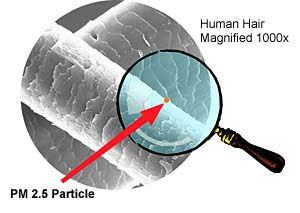 Long term exposure to small particulate pollution from combustion sources, specifically coal-fired power plants, is up to five time more likely to kill you through heart damage than other forms of natural or human-made "PM."
Long term exposure to small particulate pollution from combustion sources, specifically coal-fired power plants, is up to five time more likely to kill you through heart damage than other forms of natural or human-made "PM."
That's the conclusion of new comprehensive study comparing risks from breathing-in the tiniest specs of soot from combustion sources for over 450,000 Americans in 100 cities from 1984 to 2014. Published in the journal Environmental Health Perspectives this month to coincide with the Paris climate talks, the study has ten co-authors and promises to be a milestone in the long fight to reduce this form of pollution.
Combustion of any sort releases fine and ultra-fine particles of soot, or "Particulate Matter" in the often antiseptic regulatory-speak of environmental regulation. These specks differ from dust particles or fireplace soot in that they're much, much smaller and so can be inhaled deeper into the lungs, and then, even pass from the lungs into the blood steam to affect other organs and systems. It's their tiny size that makes PM pollution dangerous on its own. Over the last 30 years, scientists and public health officials have gone from being worried about PM 10 (10 microns or less), to PM 2.5 (2.5 microns or less – about 100th of the width of a human hair), to Ultra-fine Particles.
But soot from combustion also carries residues of whatever was being burned in the facility it came from, and this makes it doubly toxic. If you're burning coal, the soot might carry bits of Mercury, Arsenic, Cadmium and Lead, for example. The new study says that difference is what really drives up risk for people breathing-in coal plant PM.
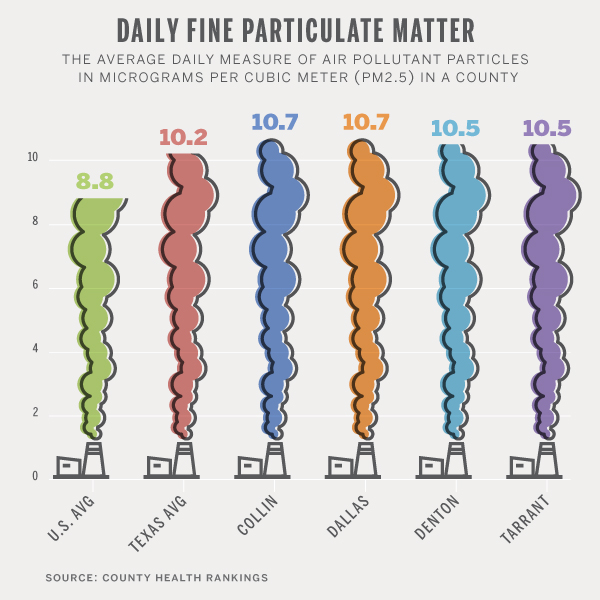
Locally, DFW is chock full of large industrial sources of combustible PM.
We're surrounded by five coal plants in an arc on its northeastern to southeastern side. That means we're downwind of their pollution, including their particulate matter pollution, most of the year. Their impact on local smog levels has recently been chronicled by Downwinders' study from UNT.
PM Pollution would follow approximately the same patterns although heavier particles fall closer to the source, while the really fine particles drift for hundreds or thousands of miles. Luminant’s 2013 Emissions Inventory submission reports 1400 tons of 2.5 particulate matter in a single year at its Big Brown plant. And that may be a severe underestimate. Big Brown’s two Units have exceeded the Texas SIP’s opacity limit of 30 percent on thousands of occasions over the past decade.
Luminant's Martin Creek plant released 2,018 pounds of mercury into the environment in 2013, according to the Toxic Release Inventory, and in fact Texas hosted the top three mercury polluters among all coal plants in the US that year.
Closer in, there's the three Midlothian cement plants with a total of four kilns now. Modernization and controls forced by 20 years of campaigning by Downwinders have brought the numbers down dramatically, but they're still huge facilities that deal in both a dusty raw material, and burning lots of coal and industrial wastes like tires and used oil, and even car parts, to turn that into a higher grade of raw material. When you burn exotic materials with coal, you turbocharge the toxicity of the PM pollution even more. In 2013, the last year the state has numbers posted online, the three cement plants released approximately 440 tons of 2.5 PM pollution.
But cement plants weren't included in the study and so the risk evaluations in it for DFW are underestimated.
Midlothian is also the home to the very large French-owned Amersteel (formally Chaparral Steel) secondary steel mill and steel mills were included as a source category in the study and were also associated with a higher mortality rate. Just about every 18-wheeler trailer you see on local highways loaded with crushed cars is headed to this facility – across the street from the TXI cement plant. Imagine the residues on the soot from melting down thousands of used cars into liquid metal. In 2013, the plant released 133 tons of PM 2.5.
But by far, the largest PM polluter in the DFW area, bar none is the Owens-Corning fibreglass plant in north Waxahahchie, along I-45. It released a whopping 300 tons of PM 2.5 pollution in 2013 alone. No other facility comes close – not the cement plants or the steel mill down 287. Not the GM plant in Arlington. It's not known how much of Owens-Corning PM is combusted however. It could be from the manufactiuring process.
Diesel engines in vehicles were also included, and the study found they has an association with higher mortality, but not nearly as significant as coal plants or steel mills. There's been a steady stream of studies tying highway pollution to respiratory and neurological illness among near-by populations, especially children. Most of the risk is assigned to PM pollution, and most of that is coming from diesels.
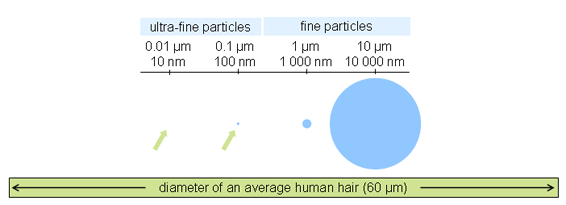
Just as important as the conclusion that coal-combusted particulate matter is significantly more dangerous than your average speck of dust is the study's indictment of current EPA risk assessments that operate on exactly the opposite assumption. The authors are critical that the Agency still weighs the risk of desert dust the same as combusted soot in computing long-term human health effects.
There are potentially enormous public heath and policy implications for North Texans in the study's conclusions.
First, the campaign to get the most modern anti-smog controls included in the latest DFW air plan has the side benefit of reducing PM pollution too. Selective Catalytic Reduction (SCR) on the cement kilns and coal plants decreases smog-forming pollution by up to 90%, and makes an effective additional PM catcher as well, increasing soot capture by 30-50%. The technology is particularly effective on the kind of PM that carries dangerous heavy metals like Mercury. Of course, retiring already-obsolete coal plants would eliminate the threat all together.
Likewise, electrification of compressors would not only lead to decreases in smog-forming emissions, but PM pollution from those sources as well.
Next, it means the already large public health costs of bad air in DFW just published by Dr. Robert Haley of UTSW in his own study are severely underestimated, since they were based on the EPA's own risk assessment software that doesn't weigh the harm of coal power plant PM differently from any other speck of PM 2.5. Adjust those numbers for the exposure to toxic soot and you could see a huge increase in lives lost, illness caused, and dollars spent.
Finally there are implications for almost very other source of combustion around – burning is bad. Where's there's a flame, a boiler, a furnace, a process that means burning something to get something in return, there's going to be PM pollution. What you burn is as important as how you burn it. Burn coal and get the residues of coal on the PM. Burn hazardous waste, and you get the residues from those wastes on the PM. Burn diesel fuel in your truck or car and get residues from that fuel mix packed away in your particulate matter.
As one of the major authors of the study said, if you want to do something about this kind of pollution – start with the most toxic forms of combusted PM. Those mostly come from large industrial sources – the coal plants, cement kilns, and compressors already in our sights because they're also smog polluters. We knew they were a problem. Now we know even more about why they're a bigger problem.
First Public Strategy Session for Texas “Fractivists” Since State Legislature Stripped Cities of Zoning Authority
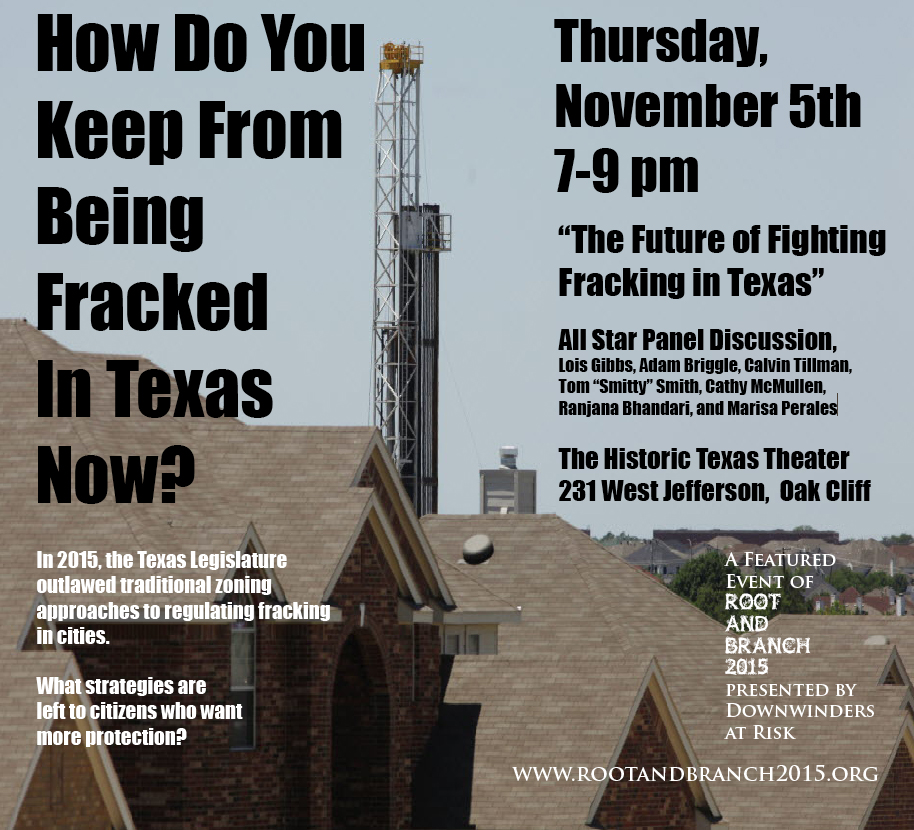 What: “The Future of Fighting Fracking in Texas”
What: “The Future of Fighting Fracking in Texas”
When: 7-9 pm Thursday, November 5th
Where: Historic Texas Theater in Oak Cliff, 231 West Jefferson
Who: Regional and Statewide Activists, Attorneys and Organizers
(Dallas)— A new alliance of groups fighting for more protective fracking regulation in Texas is using a Dallas environmental conference to host the first statewide strategy session responding to the passage of HB40 by this year’s state legislature.
Dubbing itself the “Texas Grassroots Network,” organizers include key members of local groups in Arlington, Denton, and Mansfield. Since their first meeting during the summer, they’ve also received calls from South Texas residents who live in the Eagle Ford gas and oil field. Their aim is to create something Texas has never had – a statewide coalition of grassroots groups tackling the same industry and the same problems caused by that industry setting up shop too close to people.
On the evening of Thursday, November 5th, they’re taking over Dallas’ historic Texas Theater to begin what they say will be a wide-ranging and free wheeling discussion about what the best options for those who don’t want to live side-by-side with drilling rigs in light of the legislature’s restrictions on local zoning.
“It’s time to regroup and come up new ideas and strategies about how to stop irresponsible fracking,” said Tamera Bounds, of Mansfield Gas Well Awareness. “We need to use our anger of what the legislature did to fuel new efforts and recruit new supporters. Most Texans want local control of fracking. Our job is to build a statewide movement reflecting that.”
“The Future of Fighting Fracking in Texas” is the second featured event of local clean air group’s Downwinders at Risk’s four-day floating conference, called “The Root and Branch Revue.” Other conference events include an evening of “environmental comedy” with Bar Politics, a day of workshops aimed at sharpening activist skills, and an attempt to construct “the world’s largest S.O.S” outside EPA Regional Headquarters in downtown Dallas. Lois Gibbs, of Love Canal fame, is the featured guest.
But it’s Thursday’s panel discussion and a follow-up on Saturday that could potentially have the biggest impact on the Texas environmental movement. Many opponents of urban fracking are still reeling from the state’s ban on local zoning restrictions last spring. There hasn’t yet been a coordinated or articulated response. Organizers of the Texas Theater discussion aim to fix that.
Participating will be some of the most high-profile regional fractivists, including Bounds, who’ll moderate, Adam Briggle and Cathy McMullen from Denton, Ranjana Bhandari form Arlington, and former DISH mayor Calvin Tillman. Joining them onstage on stage will be Public Citizen/Texas staffer Tom “Smitty” Smith, Austin-based environmental attorney Marisa Perales, and Lois Gibbs herself.
“HB 40 has forced us to look beyond our own city limits and find new ways to organize residents,” said Bounds. This public strategy session is one of he first steps we need to do that and regain momentum.”
Sept 23rd: Dallas is Site to One of Three National Public Hearings on EPA’s New Methane Rules – Speak Up to Include Them in Current Air Plan
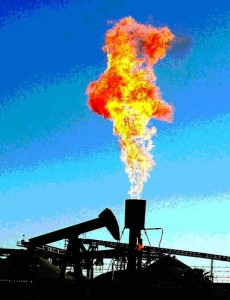 Hot off the presses, the EPA published notice in this morning's Federal Register that Dallas will be the site of one of only three national public hearings the Agency is hosting concerning its proposed rules designed to reduce methane emissions at new oil and gas indusry facilities.
Hot off the presses, the EPA published notice in this morning's Federal Register that Dallas will be the site of one of only three national public hearings the Agency is hosting concerning its proposed rules designed to reduce methane emissions at new oil and gas indusry facilities.
On September 23rd, from 9 am until 8 pm in the Dallas City Council Chambers, the EPA will be accepting testimony from the public, in five-minute increments. You can register for your five minute slot online at www.epa.gov/airquality/oilandgas/ between now and September 18th.
Announced to great fanfare only last week, the rules promise to cut future pollution levels as new equipment comes on line, but does nothing about existing faciltiies – with one important exception.
For metropolitan areas like DFW that host large concentrations of gas pollution sources AND are in violation of the Clean Air Act for their smog pollution, EPA has said that states must address new “Control Technique Guidelines” written by the Agency to reduce missions of Volatile Organic Compounds as part of thier smog-figthing plans for those areas. That's good because its smog-forming VOC pollution like Benzene and Toluene that also makes up some of the most toxic air pollution these facilities can emit. The catch is that the rules give the states a two year grace period.
That means that even though the State of Texas and EPA are wrestling over a clean air plan for DFW right now, and even though one of the major smog-polluting industries in DFW are the 17,000 or so wells, almost 700 large compressors and thousands of other oil and gas facilities in North Texas, those new Control Guidelines will not have to be included in that current plan. But they should be.
If you're going to testify, please be sure to make the request that the EPA and Texas go ahead and include these "VOC CTGs" for non-attainment areas in the current DFW air plan. These are anti-smog measures that are no-brainers in a region which has never been in compliance with the Clean Air Act. And they also mean a total reduction in hazardous air pollution.
For more information about the public hearings, contact Ms. Aimee St. Clair, Office of Air Quality Planning and Standards (E143–03), U.S. Environmental Protection Agency, byphone at (919) 541–1063, or by email at StClair.Aimee@epa.gov.
The Impact of the EPA’s New Methane Rules on the Barnett Shale? TBD
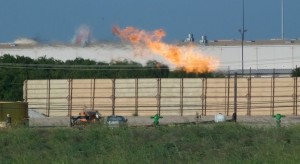 Despite all the gnashing of teeth by industry and hallelujah choruses from the Big Green groups, the new methane rules proposed by the Obama Administration this last week have no immediate impact on facts on the ground in the Barnett Shale.
Despite all the gnashing of teeth by industry and hallelujah choruses from the Big Green groups, the new methane rules proposed by the Obama Administration this last week have no immediate impact on facts on the ground in the Barnett Shale.
That’s because, like the recent coal CO2 rules, they regulate future facilities, not the 17,000 or so wells, plus infrastructure, already operating in the Barnett.
They do bring a welcome spotlight to “downstream” facilities like gathering lines and compressors, which is where most of the methane in the gas fuel cycle escapes. They also concede the connection between methane releases and smog (“…reduction of VOC emissions will be very beneficial in areas where ozone levels approach or exceed the National Ambient Air Quality Standards for ozone”), as well as methane and more toxic Volatile Organic Compounds such as Benzene and Toluene (“The measures proposed in this action achieve methane and VOC reductions through direct regulation. The hazardous air pollutant (HAP) reductions from these proposed standards will be meaningful in local communities.”)
EPA’s new rules set a floor for emissions that the industry, over time, will eventually get closer to meeting as a while with the turnover of equipment. But that could take decades. Meanwhile, the agency is only offering “guidelines” to states with smog problems – like Texas – for new pollution controls to reduce methane at existing facilities.
Under this part of the regulation, areas like DFW that host large concentrations of gas pollution sources and are officially categorized as “non-attainment” for smog, or ozone, standards will supposedly be the beneficiaries of new EPA-written “Control Technique Guidelines.”
According to EPA, these CTGs “provide an analysis of the available, cost-effective technologies for controlling VOC emissions from covered oil and gas sources. States would have to address these sources as part of state plans for meeting EPA’s ozone health standards.”
If you live in Texas, you’ve already chortled at that last sentence. Really? The Texas Commission on Environmental Quality (TCEQ) would have to use these new technologies on gas sources in their new clean air plans for DFW? Something they’ve refused to do for the last two clean air plan cycles dating back to 2010?
Well, they have to address them at least. And a lawsuit aimed at gutting the new rules is a form of addressing isn’t it?
These are guidelines only, up to the state to enforce – as the EPA admits. “States have some discretion in applying these guidelines to individual sources.” The leverage EPA has is that it still needs to approve these state-generated clean air plans and it can make an official determination that a state didn’t follow the guidelines and send it back to be amended.
This might not be all that important except that the State of Texas is going to have to write a new air plan for DFW in the next year or face the prospect of a federal plan being written in its stead. The one Austin submitted in July is already falling apart on several fronts, and TCEQ has to submit a whole new version or face an EPA-imposed one.
Will the state at least have to acknowledge these guidelines in this current air plan controversy? No. The states have two years to fold the proposed CTGs into their SIPs. So they don’t even have to come into play until this current state plan fails, and Austin or the EPA begin to write a replacement. And why might this plan fail? In part, because it doesn’t apply modern controls to major sources like oil and gas facilities.
You might remember in July, a total of 11 studies were collectively released that concluded the Barnett Shale was leaking 50 percent more methane than previously thought. The day before the EPA made its announcement this week, a national version of those studies estimated US methane pollution from oil and gas was being underestimated by 30%. That’s important because many models of air pollution used by the EPA and the states use those standard emissions estimates that now look obsolete. If you increase the amount of methane, and associated pollutants, by 30-50% in those models, the results might look very different.
So even though the state isn’t officially required to include this new approach to decreasing VOC pollution until 2017 or later, it’d be nice to see it adopted now and have an immediate impact on a region that has a longstanding chronic smog problem. But as long as Texas is in charge of writing DFW’s air plans, that’s just not gong to happen.

